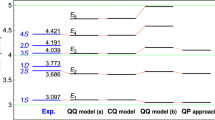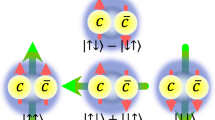Summary
Adopting a Ũ12 four-quark interaction as the potential input to the Bethe-Salpeter equation for the quark-antiquark system we can obtain nonets of bound 0− and 1− meson states. Owing to the presence of a spin-splitting term in the kernel, the masses and coupling constants of the composites deviate from the common values one uses in a phenomenological Ũ12 field theory of quarks and mesons; the magnitudes of these changes are calculated in detail.
Riassunto
Inserendo un'interazione di quattro quark invariante rispetto a Ũ12 come valore del potenziale nell'equazione di Bethe-Salpeter per il sistema quark-antiquark si possono ottenere nonetti di stati mesonici 0− e 1− legati. A causa della presenza nel nocciolo di un termine di separazione dello spin, le masse e le costanti di accoppiamento delle particelle composte deviano dai comuni valori che si usano in una teoria fenomenologica di campo dell'U 12 dei quark e dei mesoni; si calcolano dettagliatamente le grandezze di queste differenze.
Similar content being viewed by others
References
In this context we are also including the current-algebras approach, although users of this technique now employ the commutation rules themselves and abandon the bilinear quark representation for which they are derived.
H. Goldberg andY. Ne'eman:Nuovo Cimento,27, 1 (1963);M. Gell-Mann:Phys. Lett.,8, 214 (1964);G. Zweig: CERN Report (unpublished).
G. Morpurgo (Physics,2, 95 (1965)), andY. Nambu (Chicago Preprint, EFINS-65-6) show that quarks can be treated nonrelativistically when their range of interaction is large in relation to their mass. They suggest that bound mesons determine such a range.T. K. Kuo andA. Radicati (Phys. Rev.,139, B 746 (1965)) have proposed that 3 quarks bind in a 56 ground state if the 3-body force is attractive and 2-body forces are weaker but repulsive.
The idea that mesons may be regarded as spin-1/2 composites is old.N. Kemmer:Helv. Phys. Acta,10, 48 (1937);E. Fermi andC. N. Yang:Phys. Rev.,76, 1739 (1949);H. M. Moseley andN. Rosen:Phys. Rev.,80, 177 (1950). At the time, the Bethe-Salpeter equation was unknown and these authors simply introduced a potential into a relativistic two-particle equation. There have appeared two preprints from Dubna (N. N. Bogoliubow et al., D-2015 and P-2141) where the intent is the same as in this paper. However, these authors apply Klein-Gordon (in place of Dirac) operators to their Bethe-Salpeter wave functions and thereby lose essential information. This is reflected in the subsidiary conditions which they invokead hoc to cut out the unwanted positive-parity components of the full143 Ũ 12 meson multiplet.
R. Delbourgo, M. A. Rashid, A. Salam andJ. Strathdee:The Ũ 12 Symmetry, inProceedings of the Seminar on High-Energy Physics and Elementary Particles, Trieste, 1965 (I.A.E.A> Vienna). See alsoA. Tavkhelidze in the same proceedings with regard to ref. (4) The idea that mesons may be regarded as spin-1/2 composites is old.N. Kemmer:Helv. Phys. Acta,10, 48 (1937);E. Fermi andC. N. Yang:Phys. Rev.,76, 1739 (1949);H. M. Moseley andN. Rosen:Phys. Rev.,80, 177 (1950). At the time, the Bethe-Salpeter equation was unknown and these authors simply introduced a potential into a relativistic two-particle equation. There have appeared two preprints from Dubna (N. N. Bogoliubow et al., D-2015 and P-2141) where the intent is the same as in this paper. However, these authors apply Klein-Gordon (in place of Dirac) operators to their Bethe-Salpeter wave functions and thereby lose essential information. This is reflected in the subsidiary conditions which they invokead hoc to cut out the unwanted positive-parity components of the full143 Ũ 12 meson multiplet.
R. E. Marshak andS. Okubo:Phys. Rev. Lett.,13, 818 (1964). These authors have strongly advocated using the triplet quark model as a means of determining possible origins of higher symmetries. They have also consistently proposed using a fundamental triple Lagrangian from which all physical particles should materialize. However, their starting point is different from ours as they assume massless bare triplets and adopt (V-A) 4-fermi coupling. SeeR. E. Marshak: Rochester preprint UR-875-100.
This bubble approximation has lately come into much use. SeeW. Thirring:Proceedings of the 1962 Seminar in Theoretical Physics, Trieste (I.A.E.A., Vienna).
Such a course will be justified a posteriori.
Higher symmetry classifications are discussed in the review articles byA. Salam:Oxford International Conference on Elementary Particles, 1965;Y. Ne'eman:Pacific Summer School in Physics, Honolulu, 1965.
R. G. Sachs:Phys. Rev.,126, 2256 (1962);K. J. Barnes:Phys. Lett.,1, 166 (1962).
P. G. O. Freund andR. Oehme:Phys. Rev. Lett.,14, 1085 (1965).
One may even hope that the renormalized masses and couplings follow from degenerate bare values due to intermediate-state corrections which break down theŨ 4 symmetries. In this view we are estimating departures from thebare ≈U 12prescriptions.
If we identify ensuing masses with physics, ξ≈1/3 is not so small—the curvature ofK(S) becomes significant. Nevertheless the qualitative results expressed in (40) should be quite reliable.
H. J. Lipkin andS. Meshkov:Phys. Rev. Lett.,14, 670 (1965);K. J. Barnes:Phys. Rev. Lett.,14, 798 (1965).
H. J. Lipkin andA. Tavkhelidze:Phys. Lett.,17, 331 (1965);O. W. Greenberg:Phys. Lett.,19, 423 (1965).
This is quite in keeping with the ideas expressed in ref. (4) The idea that mesons may be regarded as spin—1/2 composites is old..
In deriving the following results we make use of the asymptotic (α≫1) behaviours of the integrals,\(\int\limits_1^\infty {x^{ - \rho } \left( {x - 1} \right)^\lambda e^{ - \alpha x} dx = \Gamma \left( {\lambda + 1} \right)\rho ^{ - \raise.5ex\hbox{$\scriptstyle 1$}\kern-.1em/ \kern-.15em\lower.25ex\hbox{$\scriptstyle 2$} \lambda - 1} e^{ - \alpha } \alpha ^{\raise.5ex\hbox{$\scriptstyle 1$}\kern-.1em/ \kern-.15em\lower.25ex\hbox{$\scriptstyle 2$} \left( {1 - \lambda - \rho } \right)} + 0} \left( {e^{ - x} \alpha ^{ - \raise.5ex\hbox{$\scriptstyle 1$}\kern-.1em/ \kern-.15em\lower.25ex\hbox{$\scriptstyle 2$} \left( {\lambda + \rho + 1} \right)} } \right)\).
We thank Dr.H. Rubinstein for this observation.
Author information
Authors and Affiliations
Additional information
Traduzione a cura della Redazione.
Rights and permissions
About this article
Cite this article
Daboul, J., Delbourgo, R. Departures from Ũ12 in a relativistic quark model. Nuovo Cimento A (1965-1970) 44, 1031–1046 (1966). https://doi.org/10.1007/BF02719347
Received:
Published:
Issue Date:
DOI: https://doi.org/10.1007/BF02719347




